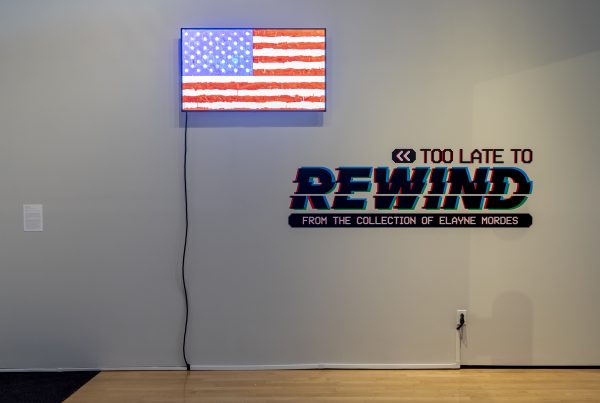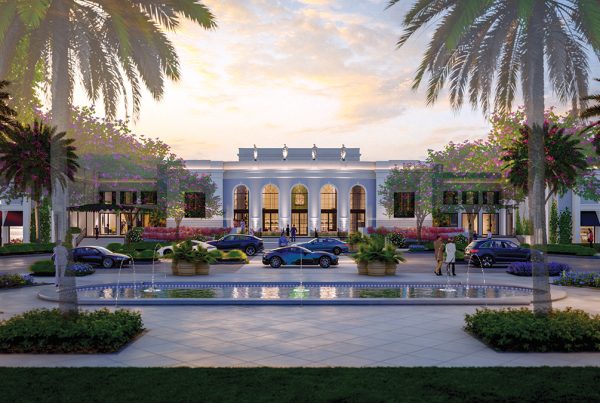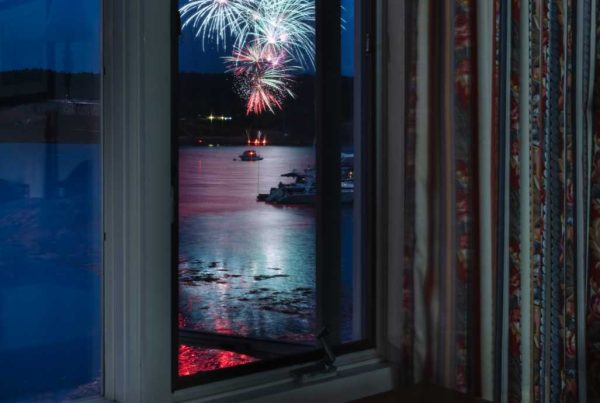To paraphrase Barenaked Ladies, there are a lot of things you could do if you had a million dollars. Renovate a historic art museum in the heart of Delray Beach is one of them.
This past summer, the Cornell Museum invested the better part of $1 million to transform its interior, courtesy of a donation from philanthropist Margaret Blume. The renovation encompassed everything from modified front and rear entrances and sleek new furnishings and window coverings to the addition of movable walls and the installation of industry-standard museum lighting.

An illustration of the new Cornell by Jennifer Lilya
Old School Square staff unveiled the Cornell “2.0” to a crowd of more than 200 guests at Wednesday evening’s grand reopening. When I visited on Thursday, Curator Melanie Johanson, who oversaw the renovation alongside Old School Square President Rob Steele and Director of Operations Marusca Gatto, told me, “we almost cried 100 times” at the previous day’s event.
The changes are both bold and subtle. Because the building’s dimensions remain the same, and the vintage pine floors and iconic staircases have likewise been maintained, the space still feels historic—and comfortably familiar. The first difference you may notice is the airiness of the gallery space. The door-shaped entrances to the side galleries have been expanded, creating an open flow from the central atrium to the four galleries; where there once were art cubicles, there is now a singular sprawl.
The museum’s modifications are both aesthetic and functional. The spindle railing on the second story has been replaced by glass paneling, which modernizes the ambience and refracts natural light from the windows onto the art. The inutile ground-floor kitchen, which had long turned half of one of the galleries into an eyesore, has been removed, beautifying the room and increasing the exhibition space.
But in terms of elevating the artistic experience, there is arguably no change more significant than the new lighting grid, installed and overseen with contemporary art in mind. To showcase the space as well as the art, Johanson’s group exhibition “Looking Glass” features reflective art that plays off the lighting and vice versa, transforming every canvas into a site-specific experience.
As inviting as it is dazzling, “Looking Glass” can be as stylish as a Fashion Week and as austere as a monastery, but it is never less than engrossing. Mediums range from aluminum and glass to photography and even some paint, sharing only their ability to reflect light—on the walls, on the floor, on objects behind the art, and on spectators themselves; the exhibit’s tagline is “Come See Your Self in the Art.”
Johanson selected 25 artists hailing from as nearby as Lake Worth and as far-flung as South Korea. Among the major figures are Olafur Eliasson, whose “Your Reversed Berlin Sphere,” which overlays an upside-down, mirrored Berlin cityscape atop a photograph, is full of intrigue and invention. There’s a roomful of Jeremy Penn, who spray-paints vintage erotic panels, cuts them into letters, and forms loaded words on mirrored backgrounds—“Indulge,” “Goddess,” “Paradise.” It’s a cool, rigorously consistent form of Pop art that by its textual nature conjures Ed Ruscha, but you kind of “get it” after two or three pieces.

I found myself more drawn to the mysteries of Leslie Shows’ “Face W,” a furious abstract amalgam of ink, paper, plexiglass and aluminum leaf that suggests the collision between a glacier and a mountain; look closely enough, and you might see an eye and a hand subconsciously form among the tundral detritus. Or Miya Ando’s “Hakkanai,” a tranquil aluminum expanse of wavy silver and off-white whose vivid blankness could set any room’s feng shui aright. Or the horror-movie kitsch of Graeme Messer, whose mirrored canvases are topped with etchings, 3-D objects such as a skeletal hand, and cautionary phrases appearing under low light as if scrawled on invisible ink: “You’re the one I’ve been looking for,” “One day you’ll be mine.”
Most of the works are apolitical, but occasionally, the artists of “Looking Glass” seem to reflect on the own “Alice in Wonderland” surreality under which we’re living. In Camilo Matiz’s circular canvas “Trendy Magnate,” the titular phrase is scrawled in neon, but only a portion of letters from each word is lit from behind: The reflection reads “End Hate.” It’s probably the most idiosyncratic and illusory repudiation of Trumpism I’ve heard.

Photo courtesy of Brea O’Donnell
But it’s the large-scale showstoppers you’ll remember most, and which best illuminate the Cornell’s redesign. Lilibeth Rasmussen’s “Outer Reflection” takes center stage in the atrium. It’s an installation of three mannequins, each composed of hundreds (thousands?) of tiny glass pieces. Circle the sculpture, and various pieces sparkle like flashbulbs. Above it hangs Lee Borthwick’s “Weeping Willow IV,” in which precisely cut ovals of mirror hang on willow branches from the artist’s family tree in a marvelous hybrid of the organic and the manufactured.
By the time I entered the upstairs “dark room” that contained the aforementioned Graeme Messer etchings, I knew I was in the presence of a show that could play PAMM, or perhaps even MoMa. It contains Daniel Rozin’s hallucinogenic “Mirror No. 5” and “Mirror No. 12.” Stand in front of these participatory pieces, and computers connected to screens will distort your image; in one, digital “pine needles” assemble vaguely into a human form. It’s trippy as hell.

Then, walk a few feet through Leah Brown and Peter Symons’ “Human Kaleidoscope II,” an interactive installation of three mirrored triangles. Your reflection bounces off the mirrors on the walls, creating many more of you.
It’s a carnivalesque funhouse in the middle of art museum. And it never could have been done in the old Cornell. Check it out yourself—more than in any other exhibition in this museum’s history, my descriptions can’t do it justice.
“Looking Glass” runs through Feb. 25 at the Cornell, 51 N. Swinton Ave., Delray Beach. Admission costs $8 adults and $5 seniors. Delray residents receive free admission on Sundays. Call 561/243-7922 or visit oldschoolsquare.org.
Top/featured image is a work by light artist Chris Wood.








Hmm! picture of my work on the front but no credit.
Chris Wood
Thanks for posting my picture and giving me credit – I loved it too! Amazing exhibit!